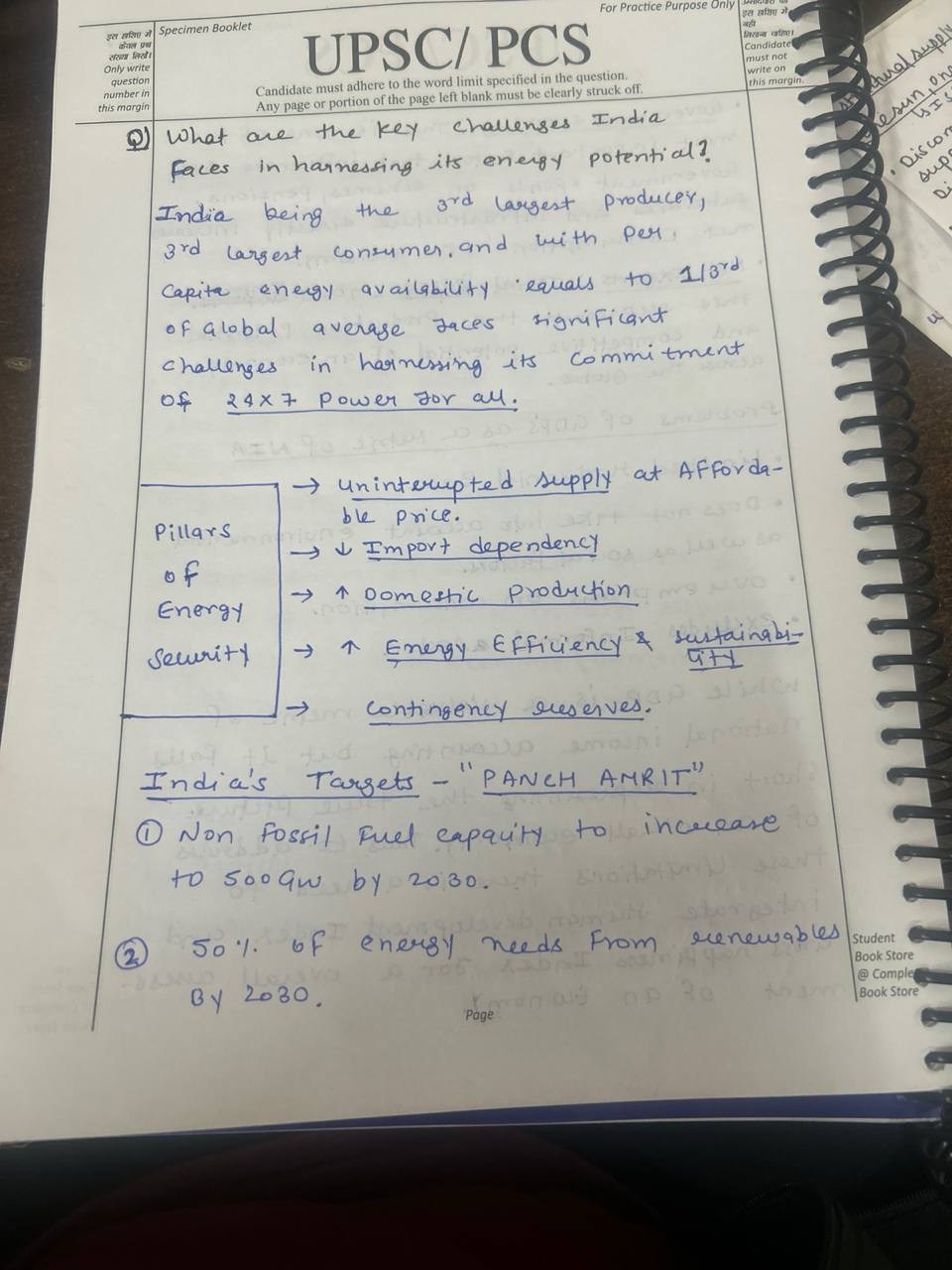Home/upsc: energy resources
- Recent Questions
- Most Answered
- Answers
- No Answers
- Most Visited
- Most Voted
- Random
- Bump Question
- New Questions
- Sticky Questions
- Polls
- Followed Questions
- Favorite Questions
- Recent Questions With Time
- Most Answered With Time
- Answers With Time
- No Answers With Time
- Most Visited With Time
- Most Voted With Time
- Random With Time
- Bump Question With Time
- New Questions With Time
- Sticky Questions With Time
- Polls With Time
- Followed Questions With Time
- Favorite Questions With Time

Discuss the approach towards increasing the emphasis on non-conventional energy sources across various regions of India. (200 words)
Model Answer Introduction India has been increasingly emphasizing the use of non-conventional or renewable energy sources to address issues like energy security, climate change, and sustainable development. These sources, including solar, wind, biomass, and tidal energy, are gaining prominence in vaRead more
Model Answer
Introduction
India has been increasingly emphasizing the use of non-conventional or renewable energy sources to address issues like energy security, climate change, and sustainable development. These sources, including solar, wind, biomass, and tidal energy, are gaining prominence in various regions of India as part of the national strategy to reduce reliance on conventional fossil fuels.
Growing Emphasis on Non-Conventional Energy in Different Regions
Government Initiatives
The Indian government has introduced several initiatives to promote renewable energy:
Conclusion
India’s growing focus on non-conventional energy sources across different regions reflects its commitment to sustainable development, energy security, and environmental preservation. With continued support and innovation, India aims to lead in the global renewable energy sector.
See lessWhat role do non-conventional energy sources play in ensuring India's energy security, and how do they complement the country's existing hydrocarbon resources? (200 words)
Model Answer Introduction Non-conventional energy sources, also known as renewable energy sources, are essential for India’s energy security. These sources, including solar, wind, hydro, and biomass, are sustainable, environmentally friendly, and naturally replenishing. Their role is becoming increaRead more
Model Answer
Introduction
Non-conventional energy sources, also known as renewable energy sources, are essential for India’s energy security. These sources, including solar, wind, hydro, and biomass, are sustainable, environmentally friendly, and naturally replenishing. Their role is becoming increasingly significant in supplementing the country’s existing hydrocarbon resources.
Role in Energy Security
Non-conventional energy sources, such as solar and wind, contribute to diversifying India’s energy mix. As of 2021, renewable energy accounted for 24% of India’s total installed power capacity, with solar and wind power leading the way. The government’s target to achieve 175 GW of renewable energy capacity by 2022, including 100 GW from solar and 60 GW from wind, highlights the growing importance of these sources.
By utilizing non-conventional energy, India can reduce its dependency on imported hydrocarbons. Currently, India imports over 80% of its crude oil and around 45% of its natural gas needs. Solar power projects in states like Rajasthan, Gujarat, and Tamil Nadu are already helping reduce reliance on coal-fired power and imported coal.
Non-conventional energy sources contribute significantly to environmental sustainability by reducing greenhouse gas emissions. For example, India’s renewable energy capacity has helped avoid approximately 49 million tons of CO2 emissions annually, showcasing the environmental advantages over traditional hydrocarbon resources.
Complementing Hydrocarbon Resources
Conclusion
Non-conventional energy sources are crucial in ensuring India’s energy security. By complementing the country’s hydrocarbon resources, they pave the way for a cleaner, greener, and more sustainable energy future.
See lessWhat are the challenges in unlocking India's lithium potential, and why is it crucial for the country's green energy transition? (200 words)
Model Answer Challenges in Unlocking India's Lithium Potential Limited Domestic Reserves: India has discovered lithium deposits in J&K, Jharkhand, and Rajasthan, but the overall reserves are limited compared to global leaders like Chile or Australia. The major find in J&K amounts to around 5Read more
Model Answer
Challenges in Unlocking India’s Lithium Potential
Significance for India’s Green Energy Transition
Conclusion
India’s challenges in unlocking its lithium potential should be seen as an opportunity for innovation and strategic growth. By addressing these challenges through sustainable practices and investments, India can pave the way for a successful green energy transition, contributing significantly to both national and global sustainability goals.
See lessWhat is the potential of tidal energy in India, and what challenges hinder its effective harnessing?(200 Words)
Model Answer 1. Potential of Tidal Energy in India India's vast coastline and specific geographical features provide significant opportunities for tidal energy generation: Geographical Scope: With a coastline of approximately 7,500 km, India holds substantial tidal energy potential. Estimated CapaciRead more
Model Answer
1. Potential of Tidal Energy in India
India’s vast coastline and specific geographical features provide significant opportunities for tidal energy generation:
2. Challenges in Harnessing Tidal Energy
a. Lack of Detailed Studies
b. High Capital Costs
c. Environmental Risks
d. Lack of Research and Development (R&D)
e. Policy Gaps
3. Way Forward
Tidal energy has immense potential to contribute to India’s sustainable energy goals if these challenges are effectively addressed.
See lessWhat are the potential sites for geothermal energy in India, and why is the country still in the early stages of utilizing this energy source? (200 words)
Model Answer Puga Valley, Ladakh: Known as India's most promising geothermal field, it has high heat flow and geothermal springs. Tatapani, Chhattisgarh: Located in the Sarguja district, this site has been extensively studied for its geothermal potential. Manikaran, Himachal Pradesh: A well-known siRead more
Model Answer
Reasons for India’s Nascent Stage in Geothermal Energy Utilization
Steps Toward Development
India aims to harness 10 GW of geothermal energy by 2030 through international collaborations with nations like the US and New Zealand. With its reliability and low carbon footprint, geothermal energy can significantly enhance India’s energy mix as infrastructure and expertise improve.
See lessCan natural gas serve as a crucial bridge in India's transition to renewable energy? (200 words)
Model Answer Roadmap for Answer Writing 1. Introduction Define natural gas and its role in energy systems. Briefly state India's energy transition goals, including the aim to achieve net-zero emissions by 2070 and the plan to increase natural gas’s share in the energy mix from 6.6% to 15% by 2030. 2Read more
Model Answer
Roadmap for Answer Writing
1. Introduction
2. Body
I. Role of Natural Gas in Bridging India’s Energy Transition
II. Challenges in Natural Gas Adoption
III. Opportunities and Strategies
3. Conclusion
Relevant Facts
This roadmap ensures a balanced and comprehensive answer structure while integrating relevant facts for analytical depth.
See lessWhat are the key challenges India faces in harnessing its energy potential? (200 words)



See lessAnalyze the role of technological innovation in enhancing the efficiency and accessibility of energy resources in India.
Technological innovation plays a crucial role in enhancing the efficiency and accessibility of energy resources in India. With its growing energy demands and commitment to sustainable development, India has increasingly relied on technological advancements to improve energy efficiency, diversify eneRead more
Technological innovation plays a crucial role in enhancing the efficiency and accessibility of energy resources in India. With its growing energy demands and commitment to sustainable development, India has increasingly relied on technological advancements to improve energy efficiency, diversify energy sources, and expand access to energy. Here’s an analysis of how technological innovation contributes to these goals:
1. Enhancing Energy Efficiency
2. Expanding Access to Energy
3. Supporting Sustainable Development
4. Challenges and Considerations
5. Strategic Recommendations
Conclusion
Technological innovation is central to enhancing the efficiency and accessibility of energy resources in India. By advancing energy-efficient technologies, expanding renewable energy solutions, and improving energy storage and management, India can address its growing energy demands while promoting sustainable development. Overcoming challenges related to costs, infrastructure, and skill development is essential for realizing the full potential of these technologies and achieving long-term energy security and environmental goals.
See lessHow do traditional biomass energy sources impact rural livelihoods and environmental sustainability in India?
Traditional biomass energy sources, such as wood, crop residues, and animal dung, play a significant role in rural livelihoods and have substantial implications for environmental sustainability in India. Here's an analysis of their impact: 1. Impact on Rural Livelihoods Energy Access and Cost PrimarRead more
Traditional biomass energy sources, such as wood, crop residues, and animal dung, play a significant role in rural livelihoods and have substantial implications for environmental sustainability in India. Here’s an analysis of their impact:
1. Impact on Rural Livelihoods
2. Impact on Environmental Sustainability
3. Strategic Recommendations
Conclusion
Traditional biomass energy sources are crucial for rural livelihoods in India, providing a primary energy source for cooking and heating, and supporting local economies. However, their use has significant environmental implications, including deforestation, soil degradation, and health risks due to indoor air pollution. Addressing these challenges requires a multifaceted approach, including promoting cleaner technologies, sustainable resource management, and supportive policies. By adopting these strategies, it is possible to balance the energy needs of rural communities with environmental sustainability and health considerations.
See lessDiscuss the significance of energy efficiency measures in reducing overall energy consumption in Indian industries.
Energy efficiency measures are crucial in reducing overall energy consumption in Indian industries, and their significance extends across economic, environmental, and operational dimensions. Here’s a detailed discussion on their importance: 1. Economic Benefits Cost Savings Reduction in Energy BillsRead more
Energy efficiency measures are crucial in reducing overall energy consumption in Indian industries, and their significance extends across economic, environmental, and operational dimensions. Here’s a detailed discussion on their importance:
1. Economic Benefits
2. Environmental Benefits
3. Operational Benefits
4. Policy and Regulatory Impact
5. Strategic Recommendations
Conclusion
Energy efficiency measures are vital for reducing overall energy consumption in Indian industries, with significant economic, environmental, and operational benefits. By implementing these measures, industries can achieve cost savings, enhance competitiveness, reduce their carbon footprint, and improve operational efficiency. Strategic investments in technology, regular energy audits, employee training, and collaboration with experts are key to realizing the full potential of energy efficiency and supporting India’s sustainable development goals.
See less